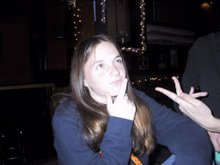A new poem surfaced in the recent issue of The New Yorker that I would like to post and look into. It's called "Master of Disguises" by Charles Simic.
Master of Disguises
Surely he walks among us unrecognized:
Some barber, some clerk, delivery man,
Pharmacist, hairdresser, bodybuilder,
Exotic dancer, gem cutter, dog walker,
The blind beggar singing, Oh Lord, remember me,
Some window decorator starting a fake fire
In a fake fireplace while mother and father watch
From the couch with their frozen smiles
As the street empties and the time comes
For the undertaker and the last waiter to head home.
O homeless old man, standing in a doorway
With your face half hidden,
I wouldn't even rule out the black cat crossing the street,
The bare light bulb swinging on a wire
In a subway tunnel as the train comes to a stop.
I was wondering if I could get some alternate interpretations of the poem. To me, the most obvious reference to "he" who walks among us is the Lord himself. Kind of like Joan Osborne's 1996 song "What If God Was One of Us." Is he this guy or that guy on the street? We'll never know, but it could be possible. Anything is possible.
I wonder why the whole poem is almost all descriptions of different people that He could be. He could have just left it as the first stanza and then continued with a new idea to branch off. Is the poet trying to just show how many possibilities it could be that he's a different person, man or woman, elite or blue collar, man or animal, light or thing?
Or, does the poet mean that we can find the Lord in any person, animal, or thing (whether that thing is reall Him or not). Like, we can be enlightened or receive the wisdom or faith we need in anyone or anything around us. Or is it just plain and simple that He could be anything anywhere?
I think my favorite part is the second stanza where the poet paints the picture of the dull, fake American family who is "frozen" as they watch a "fake fire." We all know these families. They appear solid and strong on the outside, but it's all a show. Why is the family juxtaposed into this poem? Is the undertaker brought up to reinforce death coming, that we are mortal?
Using a fire to sit in front of is even a Hellish, deathly image, as if the family is fake and has no faith, so they will go to darker places. I don't know. I'm trying to speculate.
To me, the poem has a lot of overwhelmingly dark places with a bit of light. The fire in the store. The train in a tunnel (coming to a stop). The black cat with its white eyes. The bare light bulb in the tunnel. The half hidden face of the homeless man. But they all are mentioned in the second and third stanzas--not the first. Does this represent faith or hope? How life is like on Earth? What is the purpose of these dark/light images?
So, what do you think of the poem "Master of Disguises?"
Subscribe to:
Post Comments (Atom)

No comments:
Post a Comment